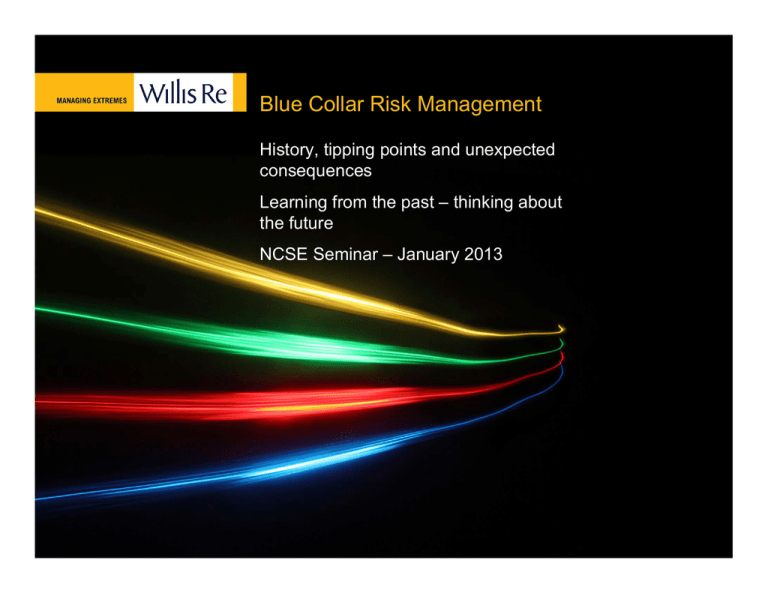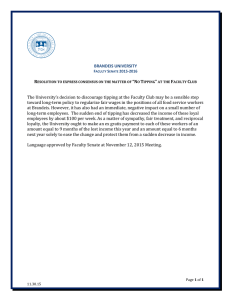Blue Collar Risk Management
advertisement

Blue Collar Risk Management History, tipping points and unexpected consequences Learning from the past – thinking about the future NCSE Seminar – January 2013 A word from our lawyers Willis Re Inc. is a reinsurance broker. Willis Re Inc. is not a law firm. We do not give legal advice and nothing herein constitutes nor should be construed as legal advice. Such ideas are offered for discussion purposes only and do not constitute legal advice. It is believed that the information used in creating this presentation is correct, but no representations are made as to its completeness or accuracy, nor are any warranties made as to its fitness for any purpose. You and your legal advisors must make an independent assessment regarding all such matters. Any comments or observations made herein are for academic purposes only and are not for the purposes of reliance. Any such comments do not reflect the views of Willis Re Inc. or its clients. The art of catastrophe risk management Knowing you’ll never get it right and being humble enough to hedge your bets Being smart enough to invest in mitigation 3 The modern four riders of the apocalypse Cognitive failure Information/intelligence failure Communication failure Political failure Every manmade or natural catastrophe has one or more of these riders: e.g.,Asbestos, 9/11, Katrina, 2011 Tohoku earthquake and tsunami, 2012 Sandy 4 In addition to the wind blowing and the earth shaking uncertainty and risk all have history… History as a risk management tool 5 Lessons from the Great Fires of the18th and 19th Century Conflagration the “climate change” of the 19th Century 6 Urban Conflagrations destroyed more property than any other peril in 19th Century The industrial revolution created conditions that make the peril of fire more lethal and destructive Cities and towns were no longer simply single or double stories homes or merchant buildings Massive factories, warehouses and multi-story tenements and great houses of banking and commerce Boston (for an example) burned in 1653, 1679, 1711, 1760, 1824, 1825, 1872 Major conflagrations New York - 1835, Chicago – 1871, Boston – 1872, Baltimore 1904 and San Francisco 1906 Source: Urban Conflagrations in the United States, William M. Shields, Ph.D page 1. 7 The modern four riders of the apocalypse in action “Nineteenth Century Americans were well aware of the combustibility of their cities…American cities and towns were, in brief, great piles of dry wood, hay, carpets, furniture, paint and lumber, literally awaiting a spark to set it all on fire” Sources: Urban Conflagrations in the United States, William M. Shields, Ph.D page 5 /. The Library of Congress,The Great Fire At Chicago, http://lcweb2.loc.gov/service/pnp/cph/3f00000/3f03000/3f03700/3f03788r.jpg 8 October 8, 1871 massive cyclonic storm from California to Pennsylvania 2,400 sq miles A Tipping Point Pehtigo, WI lost 1,200 people out of 1,700 people (exponential catastrophic risk) Source: http://lcweb2.loc.gov/cgi-bin/map_item.pl 9 The Great Fires of the 1870s were a classic tipping point Stakeholders were frightened into a common cause – Creation of National Fire Protection Association (1896) – Welcomed international help – Joined international fire safety movement Urban planning Building Fire codes resistive materials Telecommunication of alarms http://lcweb2.loc.gov/service/pnp/ppprs/00100/00113r.jpg 10 Tipping points may create conditions that allow each group to do what they do best* • NGOs /political groups • • Third parties • Influence groups Plaintiff’s Bar • Litigation • • • Government • • • • • Underwriting discipline Capital discipline Enterprise risk management Spread of risk Marketing & claims • Mitigation Post disaster relief Building codes Zoning codes Environmental protection Uninsurable risk • Insurance Industry Regulation • • Consumer protection Price & form regulation Solvency regulation 11 A success story – today U.S. urban conflagrations are stories of legend “ Public fire protection has always maintained close ties to the fire insurance industry. This fact is critical to understanding how the modern fire service developed.” Sources: Crucible of Fire, Nineteenth- Century Urban Fires and the Making of the Modern Fire Service, Bruce Hensler, Potomac Books,Copyright 2011 Kindle Loc 138/ Library of Congress, Three firemen on fire engine drawn by three horses, Washington, D.C. http://www.loc.gov/pictures/resource/cph.3c01598/ 12 Part of the 19th Century solution to conflagration was the use of asbestos which led to another tipping point 13 The problem of tipping points and unexpected consequences case study: U.S. asbestos crisis – $75 billion + (2000 new cases filed each year) Asbestos 19th and 20th Century’s “miracle cure” to the problem of conflagration BIG LAW 1965 Restatement of Torts 2nd A Tipping Point Industrial revolution 1940s 1950s 1960s 1965 1970/80s The engine: The growth of casualty insurance products (especially personal lines) The “Great Fire” crisis of the 19th Century was solved when: A tipping point was reached Stakeholders were forced to confront their cognitive biases The government, the insurance industry and the regulatory community worked together but each did what they do best: – The government created building codes that took advantage of new technology/ science and created enforcement mechanisms & incentives – The insurance industry created research facilities and underwriting disciplines to successfully underwrite fire insurance in the private market – The regulatory community protected the consumer, nurtured an orderly market, addressed market discontinuities and enforced solvency regulation 15 What extreme weather event or series of events will be the tipping point for climate change? And when? 16 Questions



